September 28, 2007
My Coney Island Baby
I recently came upon some images on the web of an installation called "My Coney Island Baby", completed in 2004. It's located at the Stillwell Avenue Subway Terminal, which is, appropriately enough, the subway stop for Coney Island in New York City.
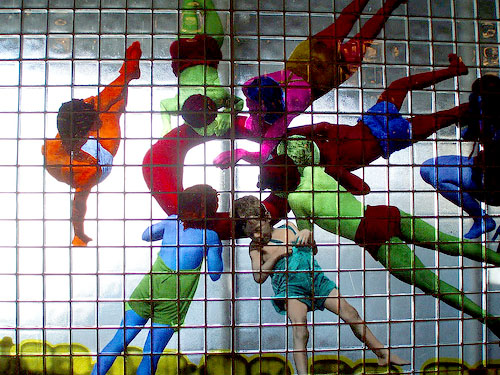
Another new direction in stained glass? or just a curiousity?
You decide.
To put the installation in context, the detail above is part of a 300 foot long 17 foot high wall made of some 4,250 3" thick glass blocks. All the images are related to different amusement park attractions at Coney Island.
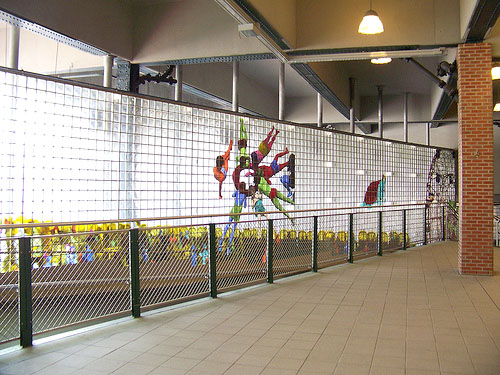
I've never been to Coney Island so I can't identify the specific images and what they represent. For instance, I believe this depicts part of the roller coaster known as 'The Cyclone', but I only surmise this from what I've read and seen on the web.
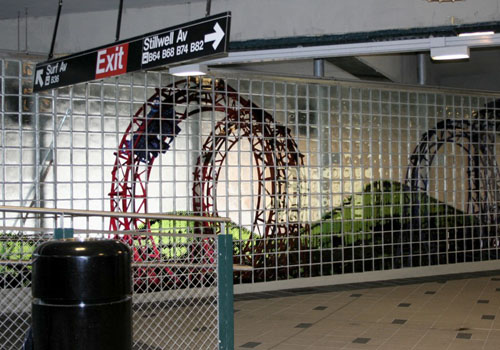
(photo by Robbie Rosenfeld)
..and I do not know what this is, other than maybe a sideshow attraction of some kind, though what specific one I've no idea.
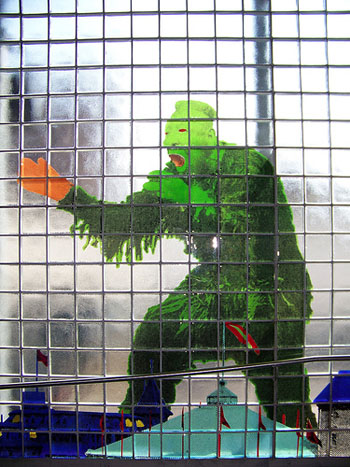
I do know that Coney Island is famous for its hot dogs, hence the 12 foot long hot dog.
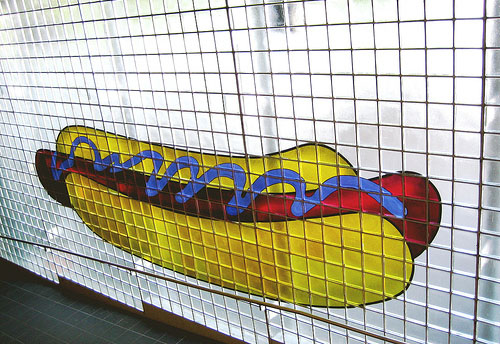
Designed by Robert Wilson, the theatre designer and director who is most famous for his collaboration with the composer Philip Glass on the Opera Einstein on the Beach. The Coney Island installation is most likely Wilson's only work that can in any way be described as 'stained glass', though he's done much 'installation art'. I was actually a little surprised to see that he designed it. I tend to associate him with a colder and more serious aesthetic. 'My Coney Island Baby' seems a bit on the light and whimsical side for him.
There are some nice big images and more 'in context' shots on this webpage by Christian Wassman, who collaborated on the piece.
Seemingly, there were many hands on this project. The images were screenprinted by Mayer of Munich in Germany, with the image sandwiched between two 1 ½ thick glass blocks to make the 3" glass blocks.
There is a description of the technical process from PittsburghCorning in this Case Study. Granted, the article is mainly plugging Pittsburgh Corning’s VISTABRIK® glass blocks that were used in the wall, but the process is described in enough detail to be an interesting read.
I found another technically based article which is more focused on the company who apparently put it all together, Glass Block of America.
There is a mention of the project on Glass block's website, but it's the exact same text of the case study as was used by the VISTABRIK® people.
Curiously, there is also an "art window" section of Glass Block's website which seems to use the same (or similar) technology tailored for smaller commissions. Unfortunately, the generic designs they use to promote this idea are pretty tame and lame.
September 14, 2007
Hypertexting the Gothic Cathedral
In searching for info on the Bourges "Jaws of Hell" photo I posted about the other day, I came upon this 'Last Judgement Window' web page by travel photographer Stuart Whatling. It's part of an ambitious work-in-progress cataloging the Bourges Cathedral Ambulatory windows in a uniquely hypertext-oriented navigational method.
Two screenshots from the site - First, the Last Judgement Window page. You can 'read' the story in brief as text, then click to see the detailed picture. I've highlighted the areas where you would click to go to the 'Hell-mouth' section.
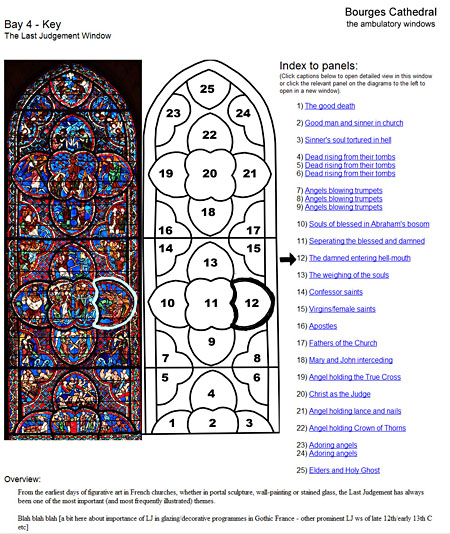
This then links to the detail of the 'Jaws of Hell' section
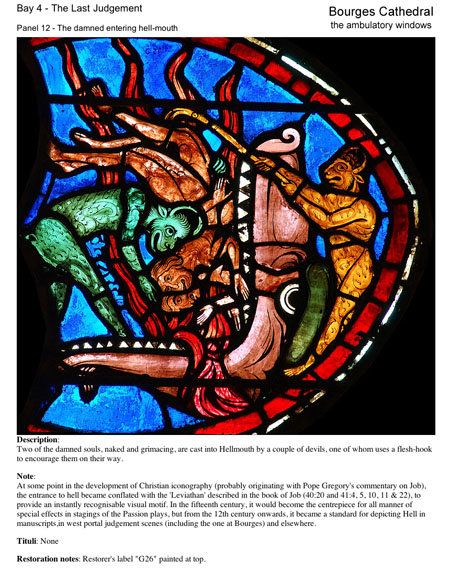
He got his idea from Alison Stone's Chartres site, hosted by the University of Pittsburgh. I linked to the Alison Stones site a while back when I did a post about Gothic Cathedral windows as comic strips. Her site remains the more comprehensive and detailed, but Stuart's is very impressive, especially considering he didn't have an academic institution backing him up. On top of that, I think his photographs are of a higher quality in general.
I only wish this kind of site could be created for all the great Gothic Cathedrals. The potential for comparison, especially in terms of narrative interpretation, is mind boggling. Just look at the Last Judgement Rose window at Chartres as compared to the Last Judgement window at Bourges ... or the Chartres Good Samaritan window compared to the Bourges Good Samaritan window.
September 11, 2007
Jaws of Hell
All in all, not a good summer, still... it could be worse...
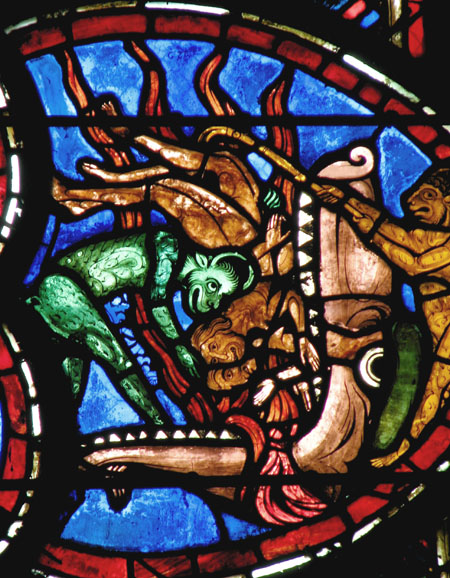
yikes.
A page from Nick in exsillo's photos on Flickr. The image is a detail from the Last Judgement window at Cathédrale Saint-Étienne de Bourges, France. Nick's photos are mostly of French Gothic Cathedrals, a large number of the photos being stained glass details. Truly truly amazing.
September 04, 2007
One Richter Reaction
Brief but interesting article in the London Times on an alleged Cologne Cathedral Controversy. I must say that I don't see it as much of a controversy seeing that the allegation of the Richter design as feeding into some kind of Islamic influence is just nonsense. The abstraction of late 20th century modernism, at least Richter's variant of it with its emphasis on randomness and chaos, is nothing akin to Islamic art with its emphasis on the precise and orderly use of ornamentation and calligraphy to convey a clear and rational, if non-figural, view of the world. Both may be 'abstract', but their views of the world are... well... worlds apart.
September 03, 2007
Labor in Stained Glass
"Labor" is not a typical topic for stained glass. So, I will let Flickr do much of the work as I am attempting on this holiday weekend to 'non-labor'.
Flickr search for 'stained glass labor'
Stained Glass Window on Basque Labor History from Flickrite 'footage'
Vialia Estacion de Abando, Bilbao, Spain
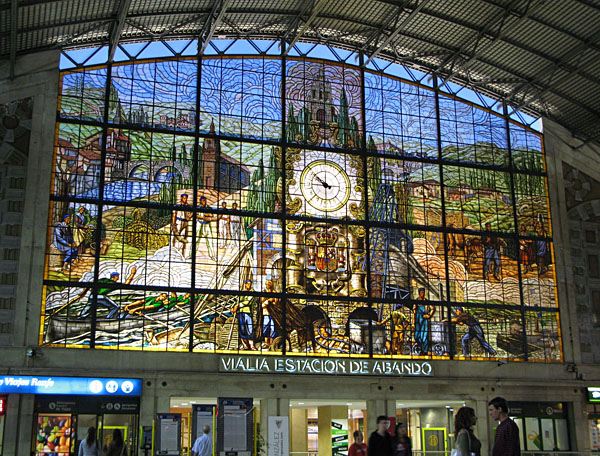
and a closer shot -
What with recent events in China and Utah, it's important to acknowledge and show support for those who risk their lives in dangerous jobs such as mining.
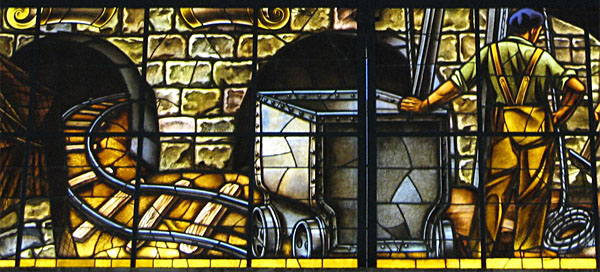
from a Flickr page by 'Donut'
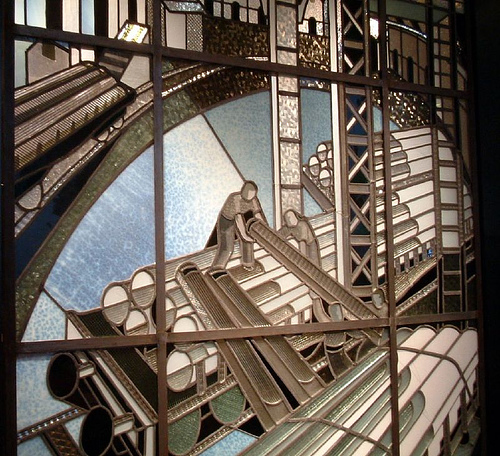
from a flickr page by 'Hoot'
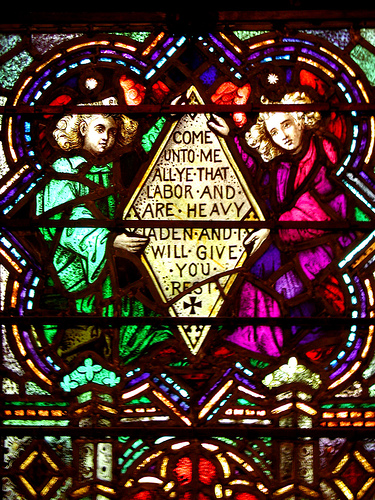
Next, a Flickr search for 'stained glass worker'
Belfast Workers
from Flickr page by 'jackeeadio'
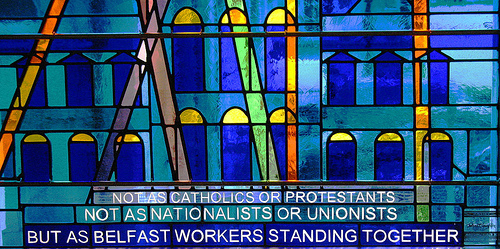
and then there are the Worker Monkeys - in The Cloisters.
via the Flickr page of 'elgatofantasma'
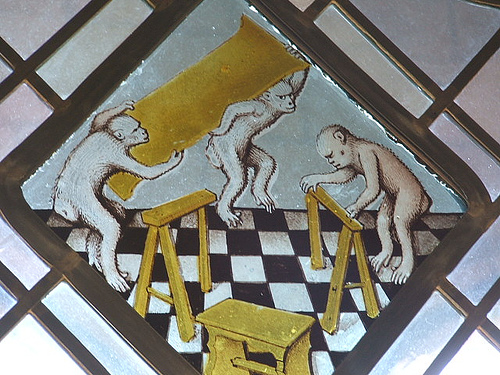
from the Flickr page of 'coloration'
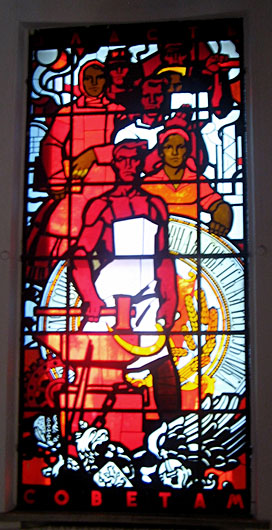
National Cathedral - Joseph Reynolds
Flickr page by rhilton © Ronald Hilton
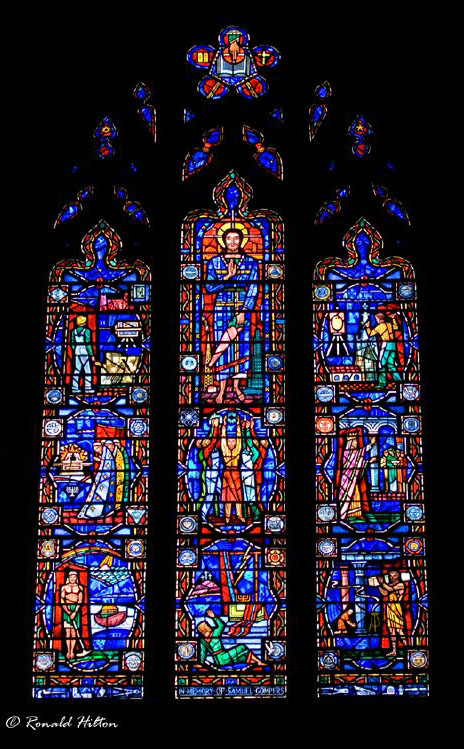
Text also from the Flickr page by rhilton
This is the third in a set of three windows created in honor of workers and laborers. In the upper left scene we can see a construction worker building the Cathedral. Directly below this is an image of the Ark of the Covenant. Below this is a depiction of Noah and the Great Flood.
In the middle lancet is Christ holding a carpenter's saw, with modern building and construction being represented below his feet.
The top of the right lancet is yet another depiction of the construction of the Cathedral. This one has a worker carving one of the pinnacles using an image on an easel to direct him. The two scenes below this subject is intended to be a representation of the building of King Solomon's temple.
Each panel has 36 AFL-CIO seals on their borders.
In the middle lancet is Christ holding a carpenter's saw, with modern building and construction being represented below his feet.
The top of the right lancet is yet another depiction of the construction of the Cathedral. This one has a worker carving one of the pinnacles using an image on an easel to direct him. The two scenes below this subject is intended to be a representation of the building of King Solomon's temple.
Each panel has 36 AFL-CIO seals on their borders.
Joseph Reynolds' pro-union support would make sense as he was a part of the studio of Francis, Reynolds & Rohnstock and that this studio (or so I heard from the Boston SG studio grapevine) was formed of workers who splintered off of the Connick Studios during a time when stained glass workers were trying to form a union in the Boston area and Connick's was resistant.